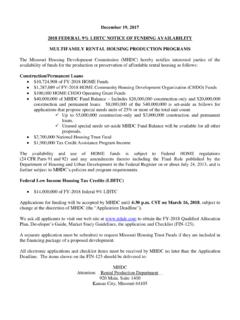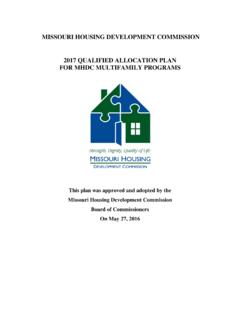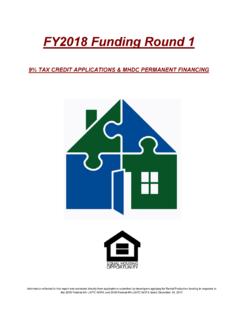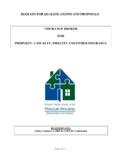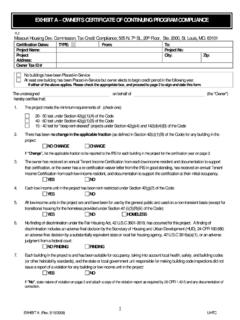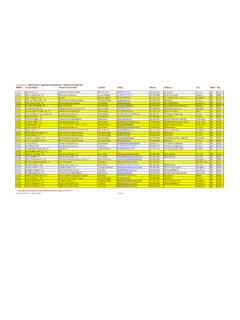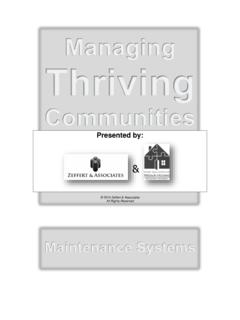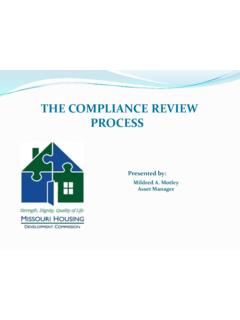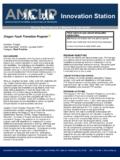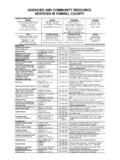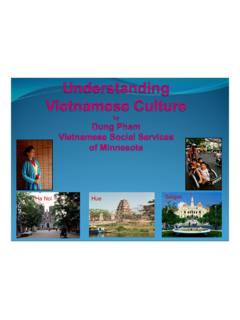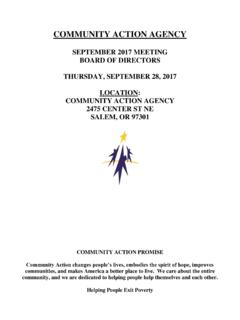Transcription of i Balance of e Continuum of Care - MHDC
1 A snapshot of a single nightin JanuaryPoint-In-Time CountJanuary 25, 2017 Missouri Balance of State Continuum of Care2017 Missouri Balance of StateReport ofSheltered & Unsheltered Point-In-Time Count of HomelessnessContentsMethodology 6 Missouri Balance of State Region Totals 7 Balance of State Quick Facts 9 Region One 10 Region Two 12 Region Three 14 Region Four 16 Region
2 Five 18 Region Six 20 Region Seven 22 Region Eight 24 Region Nine 26 Region Ten 28 State Wide Totals 30 Doubled-Up Overview 33 Homeless Youth Overview 34 MISSOURI Balance OF STATEpg.
3 6 The data in this report is gathered from 101 counties in the Missouri Balance of State (BoS) Continuum of Care (CoC). During the night of January 25, 2017, social service agencies and community volunteers in each county complete a survey for each unsheltered homeless individual and family located in the CoC. Unsheltered homeless is defined by the Department of Housing and Urban Development (HUD) as An individual or family who lacks a fixed, regular, and adequate nighttime residence, meaning: sleeping in a place not designed for or ordinarily used as a regular sleeping accommodation, including a car, park, abandoned building, bus or train station, airport, camping ground or other place not meant for human habitation.
4 Sheltered data is gathered from social service agencies and organizations providing shelter (emergency shelter, safe haven, transitional housing and hotel/motel vouchers paid for by charitable organizations) to homeless individuals and families within the BoS CoC. Together, the sheltered and unsheltered data make up the total number of homeless individuals and families in the BoS tabulating data for unsheltered homeless persons, age, gender and race percentages were calculated using the total of all unsheltered persons surveyed. The Veteran percentages were calculated using the total of all unsheltered adults surveyed, including transition age youth 18-24. The subpopulation categories of disability, those actively fleeing domestic violence, chronic homelessness, severe mental illness and substance use disorder were calculated using the total of all adults, including transition age youth 18-24.
5 Information reported by those surveyed in accordance with HUD definitions. The Youth percentages were calculated using the total of all youth, including transition-age youth living in unsheltered tabulating data for reasons for homelessness, individuals may have reported more than one factor or may have elected not to respond to this question. This information is not reported to HUD but can help improve community planning. When tabulating data for sheltered homeless persons, age, gender and race percentages were calculated using the total of all sheltered persons. The disability, those fleeing domestic violence, and Veteran percentages were calculated using the total of all sheltered adults, including transition age youth 18-24.
6 Chronically homeless percentages were calculated using the total of all households sheltered to account for both chronically homeless individuals and chronically homeless families. Unaccompanied youth percentages were calculated using the total number of children and transition age youth under 24, living in sheltered situations without a parent or legal category was used to represent information unknown at the time of entry into a shelter program or answers left blank or marked no on the survey administered to unsheltered homeless individuals and surveyed may be represented in more than one disability category. Individuals may have more than one disability documented; therefore, the totals in the disability sections of the unsheltered or sheltered responses may not equal 100 percent.
7 Although the Balance of State recognizes doubled-up individuals and families in the report, the numbers are not reported to HUD due to the federal definition of homelessness. Further, agencies assisting with the count are not required to actively seek information on doubled-up individuals and numbers in the report that follows may vary slightly from those reported to HUD in May 2017 due to HUD data quality requirements. For more information on the Point-in-Time Count, please visit the Governor s Committee to End Homelessness (GCEH) website at COUNT 2017pg. 7 Cole Clay Texas Ralls Shannon Howell Franklin NodawayCallaway Johnson Vernon Douglas StoddardReyn-olds Barry Oregon WayneWash-ingtonSaline Laclede Ozark BentonCrawford Dent HenryHarrison Camden St.
8 Clair Cass ButlerSpring-field CoC Wright Carroll PettisBoone PikeMonroe New MadridPhelpsJeffer-son Taney Joplin CoC PolkSt. Charles CoC Ripley LawrenceKan-sas City CoCOsageMillerBartonCape Gi-rardeauCooperDaviess RayPulaskiAtchisonMont-gomery Livingston Iron Dallas McDonald MariesDunk-lin Dade LewisGas-con-ade CarterSt. Lou-is County CoCSte. Genevieve StoneMadi-son Pe-mis-cot ShelbyGentry CedarPerr yHoward Mercer HoltSt. Fran-coisGrundy Marion CaldwellSt. Joseph CoCScott Clinton Mis-sissippiPlatteMoniteau HickoryWorth Bates LafayetteBollinger Morgan Macon Linn Adair Putnam Chariton Clark Knox Schuyler ScotlandSullivanRandolph Audrain12345678910 Balance of State TotalsNumber of sheltered and unsheltered homeless people by region:Sheltered & Unsheltered Totals:St.
9 Louis City CoCNumber of households:Number of People:Number of Unsheltered:Number of Sheltered:1,243952291862 Region One: 61 Region Two: 12 Region Three: 26 Region Four: 234 Region Five: 439 Region Six: 78 Region Seven: 88 Region Eight: 71 Region Nine: 60 Region Ten: 154 Number of sheltered and unsheltered homeless households by region:Region One: 45 Region Two: 12 Region Three: 12 Region Four: 127 Region Five: 325 Region Six: 53 Region Seven: 77 Region Eight: 48 Region Nine: 44 Region Ten: 101 MISSOURI Balance OF STATEpg. 8 What does homelessness Look Like?Who is homeless?Subpopulation OverviewFamilies40%Single Adults60%Unaccompanied Youth6%Sheltered vs.
10 Unshelterd77%23%<1% TransgenderEthnicityNon-Hispanic/Non- LatinoHispanic/Latino96%4%Household & Demographic ProfileHomeless Subpopulations(determined by total of all adults)Mental IllnessSubstance Use Disorder HIV/AIDSD omestic Violence16%21%<1%24%Chronic Homelessness A homeless individual or family residing in an emergency shelter, safe haven, or place not meant for human habitation for one year continuously or with four instances of homelessness that total 12 months or longer. The person must also have a disability that is expected to be long-continuing or of indefinite duration and substantially impedes their ability to live independently. 237 Individuals197 Sheltered48 Unsheltered20%80%Veterans97 % Male, 3% Female<1% Family Units82% White 15% African American3% Multiple Races 2% Hispanic 17 Chronically Homeless Veterans84 Sheltered Veterans, 14 Unsheltered100 TOTAL VETERANS98 HOUSEHOLDSU naccompanied Youth(determined by total of individuals)56 Sheltered20 Unsheltered20%80%48 Age 18-24 Age <18284132 FemaleMale3 TransgenderMale 49%Female 50%Racial DistributionWhiteBlack/ African AmericanMultiple RacesAmerican Indian/ Alaskan Native AsianUnknown72%22%3%1%1%<1%Two Veteran Family MembersPOINT-IN-TIME COUNT 2017pg.

